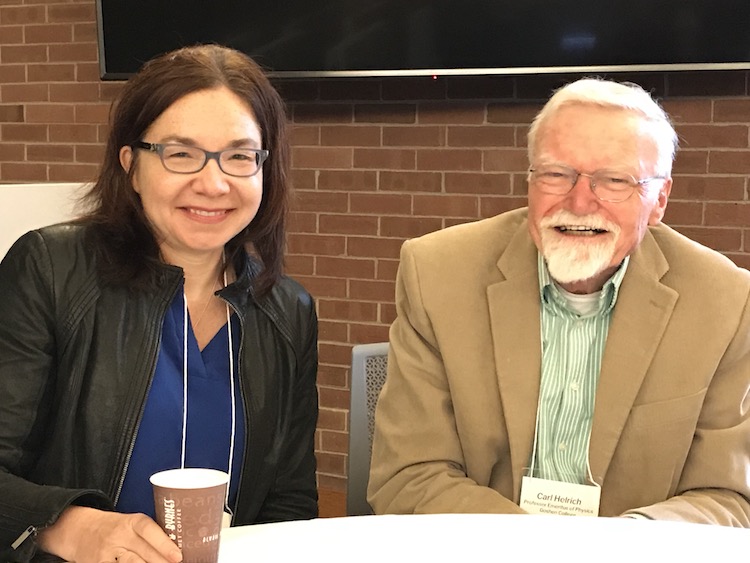 Dr. Katharine Hayhoe, a renowned atmospheric scientist who directs the Climate Science Center at Texas Tech University, Lubbock, Texas, was the featured speaker for Goshen College’s annual Religion and Science Conference March 29 to 31, 2019.
Dr. Katharine Hayhoe, a renowned atmospheric scientist who directs the Climate Science Center at Texas Tech University, Lubbock, Texas, was the featured speaker for Goshen College’s annual Religion and Science Conference March 29 to 31, 2019.
The college was doubly fortunate to host Hayhoe, who has been named one of Time’s 100 Most Influential People. The popular and engaging speaker says she gives 75% of her talks online to avoid the carbon that long distance travel requires. She selects her in-person appearances carefully in places where she can be part of a process of change already in motion.
We all have a stake in climate change
“One of the most dangerous myths we’ve bought into is that [climate change] will not affect me,” Dr. Katharine Hayhoe told the audience during a public address entitled, “Mitigate, Adapt, or Suffer: Connecting Global Change to Local Impacts.”
She was referring to data collected by the Yale Program on Climate Change Communication showing that while the majority of people in the United States believe climate change is happening and that humans cause it, most assume it will not touch their lives. In Elkhart County, 67% of people believe climate change is happening, but only 37% believe it will harm them personally.
Hayhoe pointed her audience to Purdue’s Indiana Climate Change Impacts Assessment and also offered national and international examples. She said that last year in California, forest fires burned double the number of acres that one would expect them to affect. Meanwhile, Houston, Texas, has had three 500-year flood events in three years. Kudzu, a destructive invasive species previously confined to the south is now growing as far north as Illinois and Ontario.
During discussions with peers, several attendees reported direct experience with extreme weather that is likely related to climate change. Rev. Penny Greer, board president of Nebraska Interfaith Power and Light, came from flood-ravaged Lincoln, Nebraska. She described the sludge of pollutants the floods had spread across the region. She also had not been able to do laundry for weeks due to water restrictions. Martin Hanna, a theologian from Andrews University, Berrien Springs, Mich., and a native of the Bahamas, had relatives who were experiencing seawater in their basements for the first time ever.
Endalk Degefu, a pastor from Ethiopia who is currently studying at Anabaptist Mennonite Seminary, said that droughts have worsened in his country, where 85% of the economy is based on agriculture. The rains are coming later with too much rain at once. “If the rains don’t come, we die,” he said. It is painful for him to hear there are people who deny that climate change is happening.
How do we dialog about climate change?
Hayhoe has had thousands of discussions about climate change with people of all persuasions. She and her husband discovered that they had different views on climate change several months after they were married. The two have since written a book together on the topic– A Climate for Change: Global Warming Facts for Faith-Based Decisions (2009). Working through differences in the context of intimacy and respect has enabled Hayhoe to expect positive outcomes from other conversations as well.
How can people talk about climate change in ways that are relevant, current, constructive and hopeful? Hayhoe practices a three-step process when dialoging with others. The first is to bond and connect on things both parties care about—whether it be children, food, farm work or something else. It is important that the initial contact not center on climate change.
This bond gives her a chance to explain what is happening and why both parties might care. The third step is to inspire with examples of ways people can work together to face the problem. The ability to contribute in a way that is authentic to our identities is what is most likely to change people’s minds and motivate them. Hayhoe illustrated this point with the story of a man who resisted every possible argument demonstrating human-induced climate change but was quickly convinced after he got a good deal on solar panels.
In Hayhoe’s view, discussing climate change involves helping people connect the dots between the things that are already priorities—such as health, security, and quality of life—and the effect climate change will have on them.
“People already care about a changing climate; they just don’t know it yet,” she said.
Talking about climate change frequently is an important way to enable action at the public policy level. According to Hayhoe, most politicians at the federal level believe climate change must be addressed, but they are afraid their constituents will vote them out if they name the problem and act. She told the story of Bob Inglis, a Republican representative from South Carolina who lost in the primaries in 2010 after he became convinced that climate change was an important issue.
Is it too late?
Hayhoe says she often hears this question and responds with a smoking analogy. Would a doctor tell a smoker it is too late to quit smoking? It may be too late to escape damage that has already been done, but quitting can still improve future outcomes. Hayhoe also indicated that the largest variable in climate change models is human behavior. Good choices—even now—will result in a better future.
Other conference participants had words of hope to share as well. Dr. John Buschert, a physicist who teaches at Goshen College, observed that 20 years ago, his discipline could not offer the technical solutions that climate change requires. Today, he is quite optimistic about what is technically possible if societies are able to muster the political will to employ them.
Naomi Yoder, pastor of East Goshen Mennonite Church, Goshen, Ind., was a respondent for Hayhoe’s first public lecture. It has been a challenge for her to know how to work with her congregation on a topic that seems hopeless.
“But people of faith don’t wait to begin living into hope,” she said, following up with a story about an Indigenous group in Colombia who began working toward peace long before their government thought it was possible. Their work later became a model that enabled progress at the national level.
“Rather than waiting, begin planting seeds of mitigation. Act because actions turn us toward the goodness of God,” Yoder concluded.
